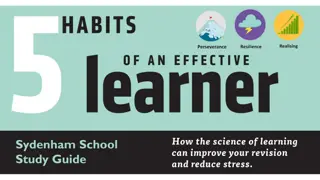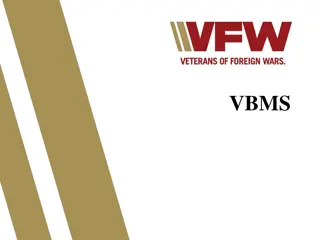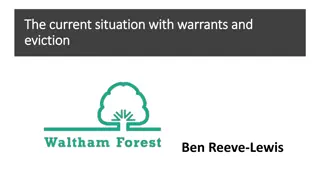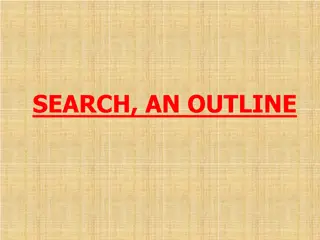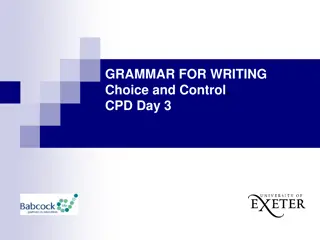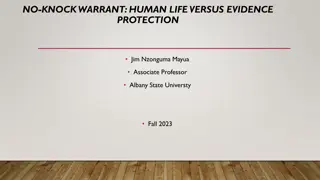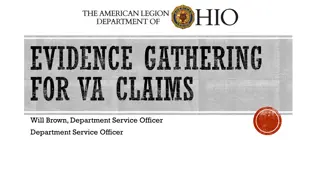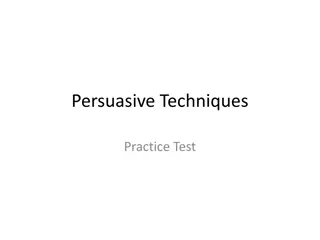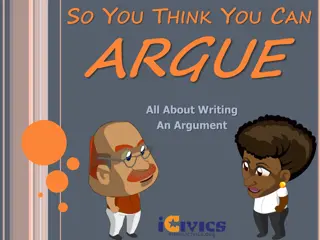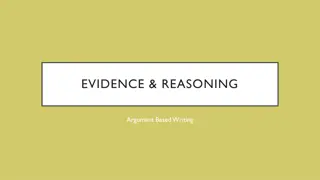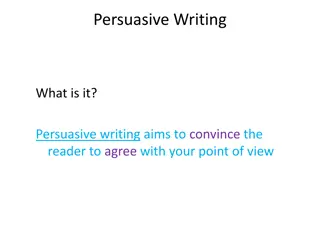Mastering Claims, Evidence, and Warrants for Persuasive Writing
Understanding the concepts of claims, evidence, and warrants is crucial for constructing persuasive arguments. Claims represent positions to persuade, evidence supports claims with facts, and warrants bridge the gap between evidence and claims. An exercise is outlined to help practice forming claims and evaluating evidence for a given thesis. Start honing your persuasive writing skills today!
Download Presentation

Please find below an Image/Link to download the presentation.
The content on the website is provided AS IS for your information and personal use only. It may not be sold, licensed, or shared on other websites without obtaining consent from the author.If you encounter any issues during the download, it is possible that the publisher has removed the file from their server.
You are allowed to download the files provided on this website for personal or commercial use, subject to the condition that they are used lawfully. All files are the property of their respective owners.
The content on the website is provided AS IS for your information and personal use only. It may not be sold, licensed, or shared on other websites without obtaining consent from the author.
E N D
Presentation Transcript
CLAIMS, EVIDENCE AND WARRANTS Zack Furness CAS100A
Claims A claim is a statement of a position that you want to persuade others to believe. Claims have different names in different contexts - they can also be called positions, propositions, hypotheses, and the focus of a body paragraph. Claims must prove your thesis. These are examples of claims: Abraham Lincoln was more interested in saving the union than in freeing the slaves. Requiring school uniforms would end bullying and hate crimes in schools.
Evidence Evidence consists of any of the following: examples, facts, observations, data, statistics, and quotations. Evidence must support your claims. These are questions you need to ask when evaluating evidence: Is there enough evidence to support the claim? Does the evidence come from an unbiased authority? Is the evidence truthful and can it be verified from a variety of sources?
Warrants A warrant shows how the evidence supports a claim. It serves as the bridge that explicitly connects the HOW and WHY of your claim. A warrant answers the following questions: How does this evidence support the claim? Why does the evidence support the claim? In other words, so what? Why is that quote or fact important for your claim?
AN EXERCISE Modified from Teaching English So It Matters
Step One Make a claim Using the following thesis, create three claims: Thesis Although many feel that requiring uniforms would positively impact public schools, school uniforms actually create negative environments. Claim 1 Claim 2 Claim 3 * Remember, claims MUST PROVE YOUR THESIS
Step Two Evaluate Evidence Read the following claims and supporting evidence. Think about whether you would accept or reject the evidence to support the claims, and why. If you reject the evidence, what kind of suggestion would you make for better evidence? Example 1 Claim: The Nittany Lions are the greatest football team of all time. Evidence: The head coach says so. Example 2 Claim: Pennsylvania is a great state. Evidence: Pennsylvania magazine says that the Pittsburgh is a beautiful place to visit. Example 3 Claim: Discipline at McKeesport High School is not very strict. Evidence: A senior who cut school five times said he only got one morning detention.
Step Three Provide a warrant Provide an effective warrant for the following claims and examples of evidence: Claim: The US government is in debt. Evidence: There will be new tax laws implemented to improve the financial situation. Warrant: Claim: Alcohol is involved in most teen car accidents. Evidence: AAA reported that teen accidents caused by drunk driving rose by 10% over the past year. Warrant: Claim: Motorcycles are extremely dangerous. Evidence: Three separate reports discussed the number of accidents last year. Warrant:




